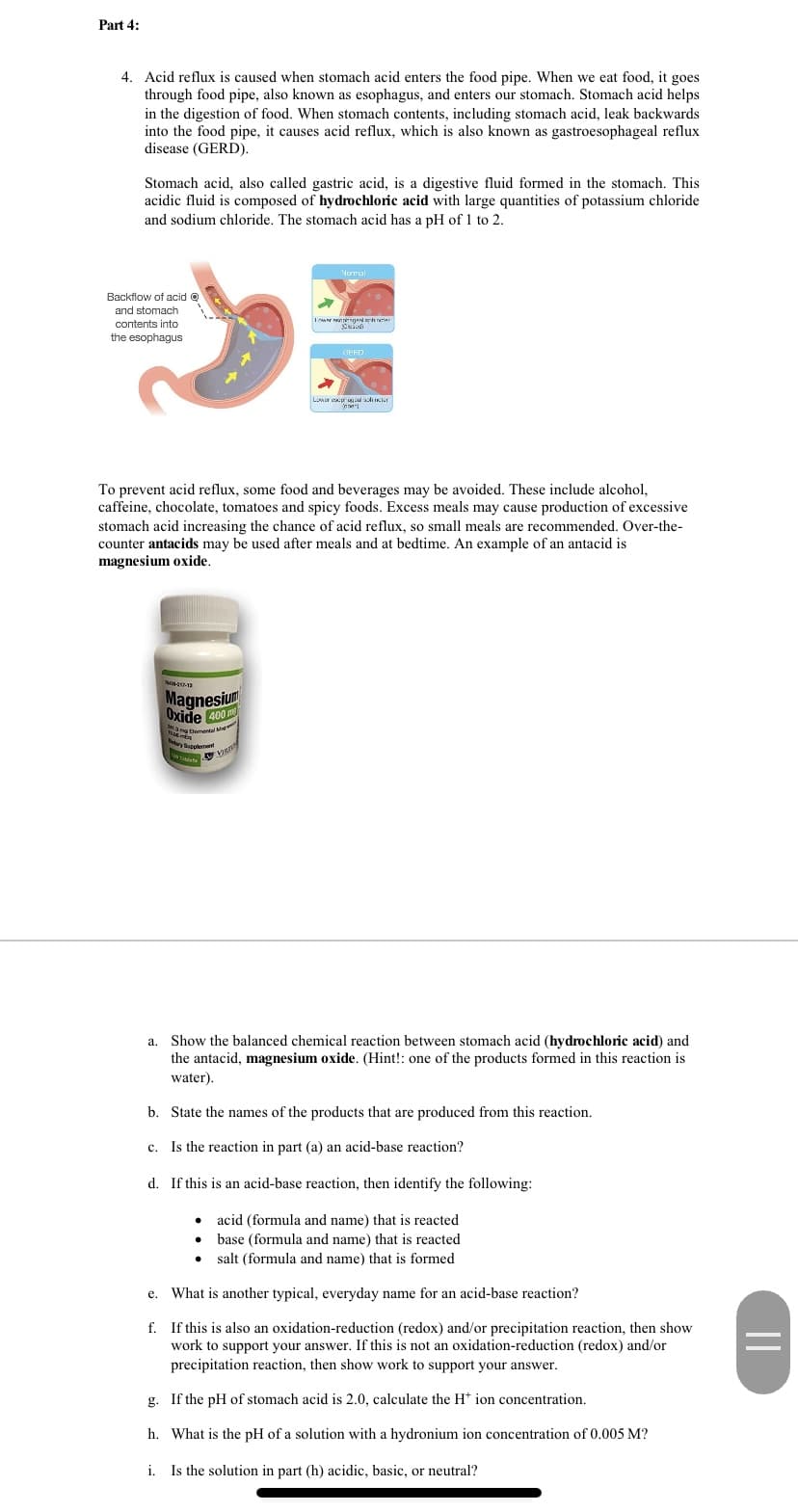d. If this is an acid-base reaction, then identify the following: acid (formula and name) that is reacted • base (formula and name) that is reacted • salt (formula and name) that is formed e. What is another typical, everyday name for an acid-base reaction? f. If this is also an oxidation-reduction (redox) and/or precipitation reaction, then sho ati
d. If this is an acid-base reaction, then identify the following: acid (formula and name) that is reacted • base (formula and name) that is reacted • salt (formula and name) that is formed e. What is another typical, everyday name for an acid-base reaction? f. If this is also an oxidation-reduction (redox) and/or precipitation reaction, then sho ati
Chapter14: Acids And Bases
Section: Chapter Questions
Problem 10RQ: For oxyacids, how does acid strength depend on a. the strength of the bond to the acidic hydrogen...
Related questions
Question
Pls show eork, will rate, D,E,F

Transcribed Image Text:Part 4:
4. Acid reflux is caused when stomach acid enters the food pipe. When we eat food, it goes
through food pipe, also known as esophagus, and enters our stomach. Stomach acid helps
in the digestion of food. When stomach contents, including stomach acid, leak backwards
into the food pipe, it causes acid reflux, which is also known as gastroesophageal reflux
disease (GERD).
Stomach acid, also called gastric acid, is a digestive fluid formed in the stomach. This
acidic fluid is composed of hydrochloric acid with large quantities of potassium chloride
and sodium chloride. The stomach acid has a pH of 1 to 2.
Nprmal
Backflow of acid Q
and stomach
contents into
the esophagus
To prevent acid reflux, some food and beverages may be avoided. These include alcohol,
caffeine, chocolate, tomatoes and spicy foods. Excess meals may cause production of excessive
stomach acid increasing the chance of acid reflux, so small meals are recommended. Over-the-
counter antacids may be used after meals and at bedtime. An example of an antacid is
magnesium oxide.
Magnesium
Oxide 400 m
y Bupplement
VIR
a. Show the balanced chemical reaction between stomach acid (hydrochloric acid) and
the antacid, magnesium oxide. (Hint!: one of the products formed in this reaction is
water).
b. State the names of the products that are produced from this reaction.
Is the reaction in part (a) an acid-base reaction?
с.
d. If this is an acid-base reaction, then identify the following:
acid (formula and name) that is reacted
base (formula and name) that is reacted
salt (formula and name) that is formed
e. What is another typical, everyday name for an acid-base reaction?
f. If this is also an oxidation-reduction (redox) and/or precipitation reaction, then show
work to support your answer. If this is not an oxidation-reduction (redox) and/or
precipitation reaction, then show work to support your answer.
g. If the pH of stomach acid is 2.0, calculate the H* ion concentration.
h. What is the pH of a solution with a hydronium ion concentration of 0.005 M?
i. Is the solution in part (h) acidic, basic, or neutral?
||
Expert Solution
This question has been solved!
Explore an expertly crafted, step-by-step solution for a thorough understanding of key concepts.
This is a popular solution!
Trending now
This is a popular solution!
Step by step
Solved in 2 steps

Knowledge Booster
Learn more about
Need a deep-dive on the concept behind this application? Look no further. Learn more about this topic, chemistry and related others by exploring similar questions and additional content below.Recommended textbooks for you


Chemistry
Chemistry
ISBN:
9781305957404
Author:
Steven S. Zumdahl, Susan A. Zumdahl, Donald J. DeCoste
Publisher:
Cengage Learning

Chemistry: An Atoms First Approach
Chemistry
ISBN:
9781305079243
Author:
Steven S. Zumdahl, Susan A. Zumdahl
Publisher:
Cengage Learning


Chemistry
Chemistry
ISBN:
9781305957404
Author:
Steven S. Zumdahl, Susan A. Zumdahl, Donald J. DeCoste
Publisher:
Cengage Learning

Chemistry: An Atoms First Approach
Chemistry
ISBN:
9781305079243
Author:
Steven S. Zumdahl, Susan A. Zumdahl
Publisher:
Cengage Learning


Principles of Modern Chemistry
Chemistry
ISBN:
9781305079113
Author:
David W. Oxtoby, H. Pat Gillis, Laurie J. Butler
Publisher:
Cengage Learning

Introductory Chemistry: A Foundation
Chemistry
ISBN:
9781337399425
Author:
Steven S. Zumdahl, Donald J. DeCoste
Publisher:
Cengage Learning